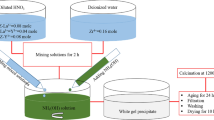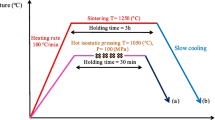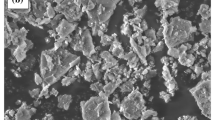Abstract
The aim of the present study was to assess the possibility of producing porous Ti–26Nb–6Mo–1.5Sn (at %) alloy using combined mechanical alloying and sintering for potential biomedical application. The use of high energy ball milling method was helpful for initial synthesis of initial elements and for obtaining a powder with particulates of different grain size, which exerts an effect on the presence and different size of pores in the alloy. X-ray diffraction results confirmed the formation of the α nanocrystalline phase and the partially phase transformation from α phase to nanocrystalline β phase during high-energy ball milling process. During the sintering process of green compacts the phase transformation to the β phase and slightly change of the lattice parameters depending on the milling time are observed. The material was also tested by the nanointedation and tribological tests, the latter being considered as a first look at the mechanical properties of the material obtained by mechanical alloying. The samples—after sintering powder mixture previously milled for 40 h—exhibit the lowest reduced elastic modulus among the studied alloys. In the case of sliding tests in Ringer’s solution, the alloy specimens exhibited a surface deformation with some visible grooves, which indicates a greater fraction of abrasive wear component during the sliding test in Ringer solution.






Similar content being viewed by others
REFERENCES
G. He and M. Hagiwara, “Bimodal structured Ti-base alloy with large elasticity and low Young’s modulus,” Mater. Sci. Eng., C 25, 290–295 (2005).
J. I. Kim and H. Y. Kim, T. Inamura, H. Hosoda, and S. Miyazaki, “Shape memory characteristics of Ti–22Nb–(2–8)Zr (at %) biomedical alloys,” Mater. Sci. Eng., A 403, 334–339 (2005).
D. C. Zhang, J. G. Lin, W. J. Jiang, M. Ma, and Z. G. Peng, “Shape memory and superelastic behavior of Ti–7.5Nb–4Mo–1Sn alloy,” Mater. Des. 32, 4614–4617 (2011).
T. Maeshima, S. Ushimaru, K. Yamauchi, and M. Nishida, “Effect of heat treatment on shape memory effect and superelasticity in Ti–Mo–Sn Alloys,” Mater. Sci. Eng., A 438–440, 844–847 (2006).
E. Eisenbarth, D. Velten, M. Muller, and J. Breme, “Biocompatibility of beta-stabilizing elements of titanium alloys,” Biomaterials 25, 5705–5713 (2004).
W. F. Ho, S. C. Wu, S. K. Hsu, Y. C. Li, and H. C. Hsu, “Effects of molybdenum content on the structure and mechanical properties of as-cast Ti–10Zr-based alloys for biomedical applications,” Mater. Sci. Eng., C 32, 517–522 (2012).
Y. Li, C. Yang, H. Zhao, S. Qu, X. Li, and Y. Li, “New developments of Ti-based alloys for biomedical applications,” Materials 7, 1709–1800 (2014).
A. Biesiekierski, J. Wang, M. A. Gepreel, and C. Wen, “A new look at biomedical Ti-based shape memory alloys,” Acta Biomater. 8, 1661–1669 (2012).
M. Niinomi, “Mechanical biocompatibilities of titanium alloys for biomedical applications,” J. Mech. Behav. Biomed. Mater. 1 (1), 30–42 (2008).
C. Caparros, M. Ortiz-Hernandez, M. Molmeneu, M. Punset, J. A. Calero, C. Aparicio, M. Fernandez-Fairen, R. Perez, and F. J. Gil, “Bioactive macroporous titanium implants highly interconnected,” J. Mater. Sci. Mater. Med. 27 (10), 151 (2016).
S. Kujala, J. Ryhanen, A. Danilov, and J. Tuukkanen, “Effect of Porosity on the osteointegration and bone ingrowth of a weight-bearing nickel-titanium bone graft substitute,” Biomaterials 24 (25), 4691–4697 (2003).
M. Karolus and J. Panek, “Nanostructured Ni–Ti alloys obtained by mechanical synthesis and heat treatment,” J. Alloys Compd. 658, 709–715 (2016).
R. B. Schwarz and C. C. Koch, “Formation of amorphous alloys by the mechanical alloying of crystalline powders of pure metals and powders of intermetallics,” Appl. Phys. Lett. 49 (3), 146–148 (1986).
G. Dercz, I. Matula, M. Zubko, A. Kazek-Kesik, J. Maszybrocka, W. Simka, J. Dercz, P. Swiec, I. Jendrzejewska, “Synthesis of porous Ti–50Ta alloy by powder metallurgy,” Mater. Charact. 142, 124–136 (2018).
G. Dercz and I. Matula, “Effect of ball milling on the properties of the porous Ti–26Nb alloy for biomedical applications,” Mater. Tehnol. 51, 795–803 (2017).
Y. Torres, J. J. Pavon, and I. Nieto, J. A. Rodriguez, “Conventional powder metallurgy process and characterization of porous titanium for biomedical applications,” Metall. Mater. Trans. B Process Metall. Mater. Process. Sci. 42, 891–900 (2011).
G. Dercz, I. Matula, M. Zubko, and J. Dercz, “Phase composition and microstructure of new Ti–Ta–Nb–Zr biomedical alloys prepared by mechanical alloying method,” Powder Diffr. 32 (Suppl. 1), S186–S192 (2017).
D. B. Wiles and R. A. Young, “A New Computer Program for Rietveld Analysis of X-Ray Powder Diffraction Patterns,” J. Appl. Crystallogr. 14, 149–151 (1981).
R. J. Hill and C. J. Howard, “IUCr, quantitative phase analysis from neutron powder diffraction data using the Rietveld method,” J. Appl. Crystallogr. 20, 467–474 (1987).
G. Dercz, D. Oleszak, K. Prusik, and L. Pajak, “Rietveld-based quantitative analysis of multiphase powders with nanocrystalline NiAl and FeAl phases,” Rev.Adv. Mater. Sci. 18, 764–768 (2008).
G. Williamson and W. Hall, “X-ray line broadening from filed aluminium and wolfram,” Acta Metall. 1 (1), 22–31 (1953).
G. Dercz, I. Matula, M. Zubko, and A. Liberska, “Structure characterization of biomedical Ti–Mo–Sn alloy prepared by mechanical alloying method,” Acta Phys. Pol. A 130, 1029–1032 (2016).
C. Suryanarayana, “Mechanical alloying and milling,” Prog. Mater. Sci. 46 (1–2), 1–184 (2001).
V. Uvarov and I. Popov, “Metrological characterization of X-ray diffraction methods for determination of crystallite size in nano-scale materials,” Mater. Charact. 58, 883–891 (2007).
C. Salvo, C. Aguilar, R. Cardoso-Gil, A. Medina, L. Bejar, and R. V. Mangalaraja, “Study on the microstructural evolution of Ti-niobium based alloy obtained by high-energy ball milling,” J. Alloys Compd. 720, 254–263 (2017).
G. Dercz, L. Pajak, and B. Formanek, “Dispersion analysis of NiAl–TiC–Al2O3 composite powder ground in a high-energy attritorial mill,” J. Mater. Process. Technol. 175, 334–337 (2006).
C. Aguilar, P. Guzman, S. Lascano, C. Parra, L. Bejar, A. Medina, D. Guzman, “Solid solution and amorphous phase in Ti–Nb–Ta–Mn systems synthesized by mechanical alloying,” J. Alloys Compd. 670, 346–355 (2016).
G. Dercz, K. Prusik, L. Pajak, T. Goryczka, B. Formanek, “X-ray studies on NiAl–Cr3C2–Al2O3 composite powder with nanocrystalline NiAl phase,” J. Alloys Compd. 423, 112–115 (2006).
G. Dercz, B. Formanek, K. Prusik, and L. Pajak, “Microstructure of Ni(Cr)–TiC–Cr3C2–Cr7C3 composite powder,” J. Mater. Process. Technol. 162–163, 15–19 (2005).
L. M. R. de Vasconcellos, D. O. Leite, F. N. de Oliveira, Y. R. Carvalho, and C. A. A. Cairo, “Evaluation of bone ingrowth into porous titanium implant: Histomorphometric analysis in rabbits,” Braz. Oral Res. 24, 399–405 (2010).
A. I. Itälä, H. O. Ylanen, C. Ekholm, K. H. Karlsson, and H. T. Aro, “Pore diameter of more than 100 µm is not requisite for bone ingrowth in rabbits,” J. Biomed. Mater. Res. 58, 679–683 (2001).
Y. V. Milman, A. A. Golubenko, and S. N. Dub, “Indentation size effect in nanohardness,” Acta Mater. 59, 7480–7487 (2011).
I. Manika and J. Maniks, “Size effects in micro- and nanoscale indentation,” Acta Mater. 54, 2049–2056 (2006).
M. Geetha, A. K. Singh, R. Asokamani, and A. K. Gogia, “Ti based biomaterials, the ultimate choice for orthopaedic implants—A review,” Prog. Mater. Sci 54, 397–425 (2009).
W. Waldhauser, J. M. Lackner, M. Kot, and B. Major, “Dry and ringer solution lubricated tribology of thin osseoconductive metal oxides and diamond-like carbon films,” Arch. Metall. Mater. 60, 2139–2144 (2015).
X. Li and U. Olofsson, “A Study on friction and wear reduction due to porosity in powder metallurgic gear materials,” Tribol. Int. 110, 86–95 (2017).
Y.-S. Lee, M. Niinomi, M. Nakai, K. Narita, and K. Cho, “Differences in wear behaviors at sliding contacts for β-type and (α + β)-type titanium alloys in Ringer’s solution and air,” Mater. Trans. 56, 317–326 (2015).
Funding
This work was supported by the Polish National Science Centre (Polish: Narodowe Centrum Nauki, abbr. NCN) under the research project no. 2011/03/D/ST8/04884 and no. 2016/23/N/ST8/03809.
Author information
Authors and Affiliations
Corresponding author
Rights and permissions
About this article
Cite this article
Dercz, G., Matuła, I. & Maszybrocka, J. Properties of Porous Ti–26Nb–6Mo–1.5Sn Alloy Produced via Powder Metallurgy for Biomedical Applications. Phys. Metals Metallogr. 120, 1384–1391 (2019). https://doi.org/10.1134/S0031918X19130040
Received:
Revised:
Accepted:
Published:
Issue Date:
DOI: https://doi.org/10.1134/S0031918X19130040




